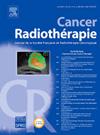Defining the potential for sexual structures-sparing for prostate cancer external beam radiotherapy: A dosimetric study
IF 1.4
4区 医学
Q4 ONCOLOGY
引用次数: 0
Abstract
Purpose
The purpose of the study was to evaluate the dosimetric impact of sexual-sparing radiotherapy for prostate cancer, with magnetic resonance-only treatment planning.
Material and methods
Fifteen consecutive patients receiving prostate cancer radiotherapy were selected. A synthetic CT was generated with a deep learning method from each T2-weighted MRI performed at the time of treatment planning. For each patient, two plans were performed: standard treatment planning and sexual-structures sparing treatment planning. The treatment plan was designed to deliver a dose of 78 Gy to the prostate and 50 Gy to the seminal vesicles in 2 Gy daily fractions, using volumetric arc therapy. Dose–volume histograms were computed to compare treatment plans.
Results
All plans fulfilled dosimetric objectives and were equivalent regarding planning target volume coverage. The doses delivered to both rectum, bladder, and femoral heads were similar between plans (P = 0.20). Sexual-sparing plans enabled to decrease all dosimetric parameters on sexual organs-at-risk. The mean penile bulb dose in sexual-sparing plans was significantly reduced (21.1 Gy ± 20.7 versus 13.4 Gy ± 14.0, P < 0.01), however with large variability observed between individuals. The mean dose delivered to the corpora cavernosa was also significantly reduced within sexual-sparing plans (13.1 Gy ± 16.7 versus 8.6 Gy ± 10.4, P < 0.01). A significant reduction was also observed in the highest doses delivered to internal pudendal arteries (D10%: 48.4 Gy ± 8.3 versus 33.1 Gy ± 4.6, P < 0.05; D5%: 52.0 Gy ± 8.7 versus 36.8 Gy ± 5.5, P < 0.05).
Conclusion
Sparing of sexual structures appears feasible, without compromising neither planning target volume coverage nor doses delivered to non-sexual organs at risk. The clinical significance of this dose-reduction requires prospective evaluation.
确定前列腺癌体外放射治疗保留性结构的潜力:剂量学研究。
目的:该研究旨在评估前列腺癌保留性放射治疗的剂量学影响,仅使用磁共振进行治疗规划:选取了15名连续接受前列腺癌放疗的患者。在制定治疗计划时,利用深度学习方法从每个 T2 加权磁共振成像中生成合成 CT。为每位患者制定了两种治疗计划:标准治疗计划和性结构疏通治疗计划。治疗计划的设计是采用体积弧形疗法,每天以2Gy的分量向前列腺输送78Gy的剂量,向精囊输送50Gy的剂量。计算剂量-体积直方图以比较治疗方案:结果:所有方案都达到了剂量学目标,在计划目标体积覆盖范围方面也不相上下。不同方案对直肠、膀胱和股骨头的剂量相似(P=0.20)。保留性器官的计划能够降低性器官风险的所有剂量参数。在性器官保留计划中,阴茎球部的平均剂量显著降低(21.1Gy±20.7 对 13.4Gy±14.0):保留性器官结构似乎是可行的,既不会影响计划目标容积的覆盖范围,也不会影响投放到有风险的非性器官的剂量。这种剂量减少的临床意义需要进行前瞻性评估。
本文章由计算机程序翻译,如有差异,请以英文原文为准。
求助全文
约1分钟内获得全文
求助全文
来源期刊

Cancer Radiotherapie
医学-核医学
CiteScore
2.20
自引率
23.10%
发文量
129
审稿时长
63 days
期刊介绍:
Cancer/radiothérapie se veut d''abord et avant tout un organe francophone de publication des travaux de recherche en radiothérapie. La revue a pour objectif de diffuser les informations majeures sur les travaux de recherche en cancérologie et tout ce qui touche de près ou de loin au traitement du cancer par les radiations : technologie, radiophysique, radiobiologie et radiothérapie clinique.
 求助内容:
求助内容: 应助结果提醒方式:
应助结果提醒方式:


